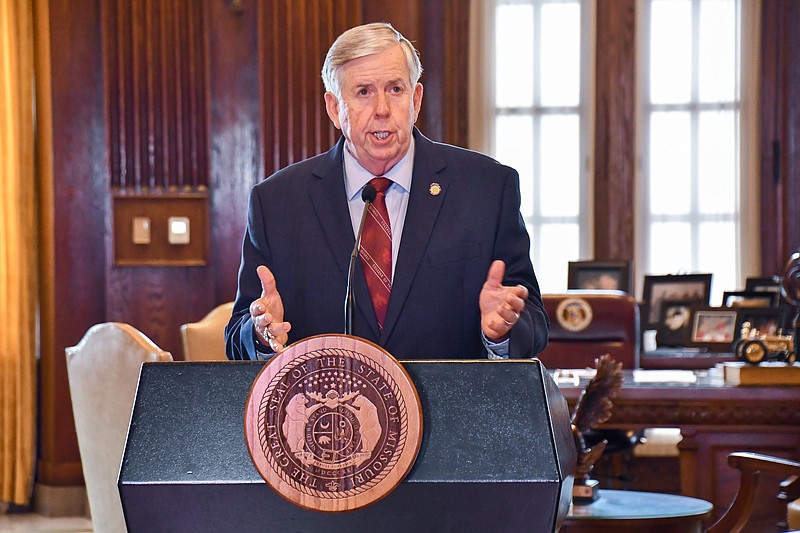Gov. Mike Parson outlined Thursday the three strategies Missouri will use to reach his stated goal of conducting 7,500 COVID-19 tests per day, while Missouri's public health director said the state is not reporting separate antibody test results in a way that can lead to discrepancies in pandemic data - as the federal government and a few other states have done.
On the three testing strategies, Parson said Missouri will use box-in, sentinel and community sampling approaches - each one with a goal of how many tests are to be conducted each day.
Parson said the box-in approach will focus on congregate living facilities - especially long-term care facilities where there's been at least one positive case among residents, staff or both. He said the goal is to conduct 1,850 such tests per day.
Long-term care facilities may include residential care, assisted living, intermediate care and skilled nursing communities. The definition of congregate living facilities may also include places such as jails, prisons, mental health facilities, dormitories and resident summer camps but not hospitals, apartments or condominiums, according to an order from the Missouri Department of Health and Senior Services issued on Monday.
That order requires all congregate living facilities where at least one resident or staff member tests positive for COVID-19 to notify DHSS and local health authorities within 24 hours of learning of the positive test result.
The reason for that requirement is to then have everyone at the facility tested, to try to contain an outbreak before it can get going - box it in.
Parson said 163 long-term care facilities have had at least one positive case, either among residents, staff or both.
He said last Monday that of 91 of those 163 facilities that had an active case of COVID-19 within the past two weeks, work this week would focus on getting the remaining 50 of those 91 that had not had facility-wide testing completed to do so.
The second testing strategy - sentinel testing - is also focused on containment, but it's meant to proactively identify people who may be infected but not showing symptoms.
Parson said sentinel tests would be conducted at state-owned facilities across 28 counties, including facilities of the Missouri departments of Corrections, Mental Health and Social Services, as well as homes of the Missouri Veterans Commission. He said the goal is to conduct 1,440 such tests each day during a 10-day period.
Community sampling testing, the third strategy, is aimed to determine the prevalence of COVID-19. Parson said the goal is to conduct 975 such tests per day.
Community sampling is not limited to certain facilities, but instead involves authorities setting up testing sites in a county, and inviting any resident who wants to be tested to do so - regardless of whether they're showing symptoms.
This has been done in 13 counties already, and over the next 10 days, the state will focus on six more counties: Boone, Cape Girardeau, Greene, Jackson, Jefferson and St. Charles.
If this sort of testing shows a low prevalence of COVID-19 in an area, Parson said, it will give people the confidence to re-engage in their communities and the economy.
He said "just because we come to your community does not necessarily mean that there has been a spike or outbreak in your area. The selection of these counties is based on location and the ability to draw participants from a broader region, and locations that have expressed a need for additional testing resources."
The stated numbers for the three testing strategies do not add up to 7,500 tests per day, but DHSS' director Dr. Randall Williams said that's because those numbers - which add up to more than 4,200 - are being added to the 3,500-4,000 clinical tests being done each day.
Parson said the expanded testing will be paid for using funding through the federal Coronavirus Aid, Relief and Economic Stability Act, but also that if local health authorities have received money, they will be expected to help.
Williams said the state has also received a further $135 million for testing in addition to CARES Act funding for local governments to pursue testing.
Williams also said the testing goals and the testing data posted on DHSS' website do not include antibody testing results.
"About four states have gotten in a lot of trouble because they tried to inflate their numbers," Williams said - alluding to reports that Georgia, Pennsylvania, Texas and Vermont have been mixing test results for active COVID-19 cases and antibody results that show past exposure to COVID-19.
Doing that - as the Centers for Disease Control and Prevention has also admitted to doing - can make it difficult to tell how many people are actually being tested for active cases of COVID-19, and can drive down the rate of positive results.
Williams said, "We don't do that here in Missouri."
He added about 13,000 antibody tests had been done.
Since the first reported COVID-19 case in Missouri in March, 172,946 people had been tested for an active infection, as of Thursday afternoon, according to DHSS' website.
The positivity rate among all those tests was 6.6 percent, with a total of 11,340 lab-confirmed COVID-19 cases.

